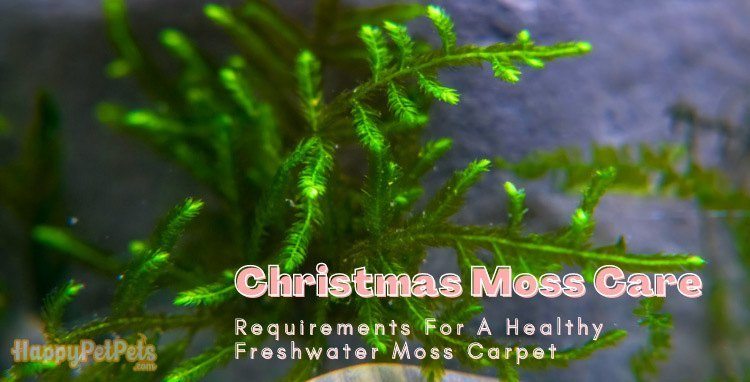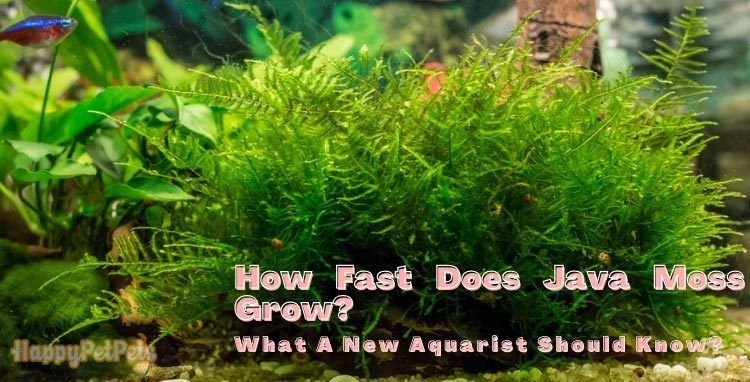Christmas moss is among the most largely used aquatic species in aquarium husbandry. It can form an eye-catching carpet moss, adding a natural ecosystem look to your tank.
For a beginner, Christmas mosses may be challenging to plant and maintain. There will be issues arising during the process, which you’ll encounter when growing any aquatic moss.
Don’t worry! With our useful information about Christmas moss care, you’ll be able to keep a beautiful freshwater aquarium with confidence.
What Is Christmas Moss
Christmas moss originates from tropical areas around Asia, such as Japan, the Philippines, India, and Thailand. It’s a member of the creeping moss family, which grows slowly and short but can get extremely wide.
People also call it Vesicularia montagnei, but that’s the scientific name. Indeed, the usual name ‘Christmas’ is based on its mature branches’ shape. These branches hang down and overlap each other, forming the shape of a beautiful fish tank Christmas tree.
Fish keepers grow Christmas moss to raise tadpoles and fish fry since it provides cover from cannibalistic parents and predators. Also, it’s one of the food sources for young fish as well as young aquatic creatures.
This moss is a charming foreground and midground plant, creating such a beautiful green carpet running along your aquarium’s floor.
What Are Common Problems
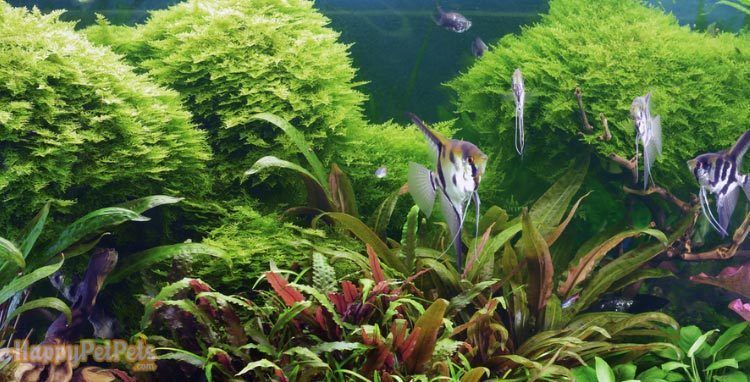
Christmas moss has common problems, just as when you take care of other mosses
Vesicularia montagnei moss is not that difficult to raise; however, the process is not as easy as when you’re planting other species, like Java moss.
One of the most common issues about aquatic creatures, by and large, and Christmas moss specifically is melting.
If the carer plucks off any dying part of the moss before it starts rotting, she’s ruined the moss extension. The melting occurs, meaning that the new aquatic growth disappears.
Another problem you may have to face is Algae. Algae is the top enemy of your plants. It can outcompete or choke out the moss.
Algae suggest that your aquarium scape is suffering from a poor, unbalanced ecosystem. The carer might have provided the plants with too much lighting or excessive nutrients. You should note it down because, without one of those factors, algae won’t have a chance to spread.
Plant debris is also a relative issue. If you put in some fry, shrimplets, or snails, you can ensure a neat freak as these creatures would munch on debris plants. Otherwise, not only will the mess infuriate you but also pose water quality problems.
Breeders usually compare Christmas moss vs. Java moss in terms of ease of care. Indeed, Java is the easiest type of moss to look after, suiting a beginner’s skills.
Nevertheless, Christmas moss is a fantastic alternative to Java moss because of its nice appeal, ability to cover fish, and ideal food source for fry.
Christmas Moss Care Requirements
The beauty of Vesicularia montagnei moss is that it’s pretty versatile and hardy. The plant can survive in almost any environment.
When growing Christmas moss, you have to remember this one is native to freshwater areas. So it is prone to a high level of salinity, which can kill your plant in weeks or days.
Aside from that, you don’t have to worry too much about caring for Christmas moss. Bear all the conditions below in mind to keep your plants healthy.
Water Paraments
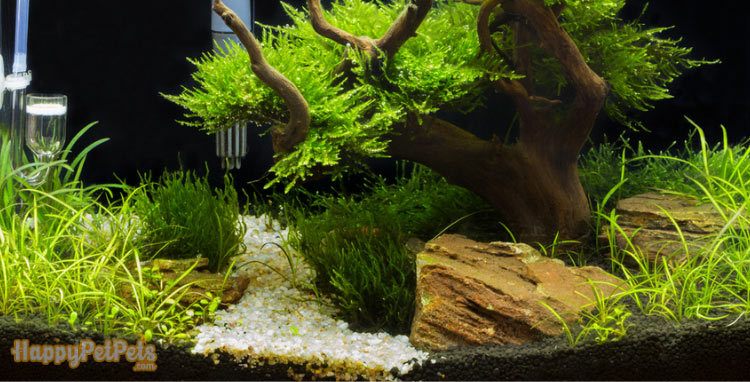
Any water feature can affect your Christmas moss’s health
The first condition to create a balanced environment for your Christmas moss aquarium is adequate water temperature. The moss lives best under the temperature of 65-77 degrees F, roughly the same as room temperature.
The water hardness is also a noteworthy factor. In particular, the ideal amount of magnesium and calcium dissolved in the water should be between 5 and 20dH – fairly soft compared to other mosses.
Plus, you need to keep an eye on the pH level or the acidity of the tank water. Christmas moss benefits best from slightly neutral and slightly basic water.
It’s advisable to keep the acidity anywhere between 5.0 and 7.5, given that 5.0 is a bit acidic while 7.5 is somewhat basic.
As mentioned, a waste-free environment is extremely necessary for your moss’s health. Putting in snails can help you clean the decomposing plants, but it’s not enough to keep a balanced biological ecosystem in your freshwater tank.
Instead, we suggest you invest in a good-quality aquarium filtration system.
Some filters, like Penn Plax Cascade 1000, Canister filter, or Fluval FX6 canister filter, are highly recommended. These heavy-duty devices apply well to large tanks, delivering powerful mechanical, biological, and chemical filtration.
Lighting
Vesicularia montagnei enjoys all lighting conditions, particularly bright yet indirect light. However, you should avoid exposing it to excessive amounts of light as well as direct sunlight.
The overly bright sunlight will dry out your sensitive plant, whereas exposure to light for a long period of time can put a check on the moss’s growth rate.
Location
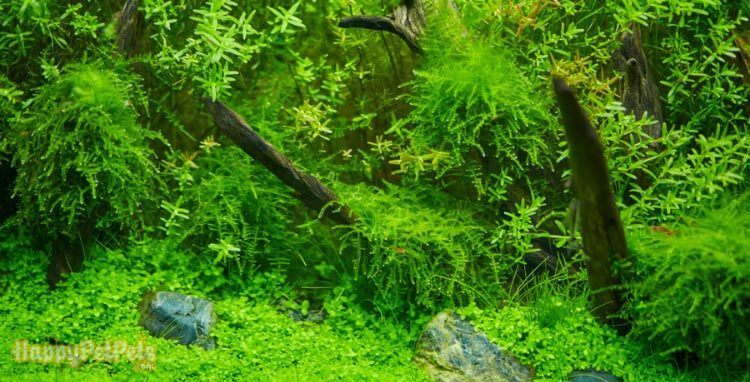
The breeder can place Christmas moss in the back to create a background wall
The breeder can place Vesicularia montagnei anywhere in his aquascape. It’ll thrive no matter the location.
However, many experienced hobbyists usually put it in the back, side, or bottom of the fresh water tank to generate a beautifully green Christmas moss carpet. This wall effect not only gives your aquarium a nice decoration but is also an ideal hiding place for small creatures, like young fish.
Should you want to create an attractive wall with this aquatic moss, a tip for you is to attach the plant to some mesh materials using a home fishing line. Wait for it to start to grow, then you can get the wall you desire.
Nutrients
Christmas moss’s common nutrient is fertilizer. The plant is not really fertilizer-starving, but it does need a CO2-like source of food. So, it will appreciate any fertilizer you add to the tank.
Many Christmas mosses grow in a transition or splash zone between the air and water. Thus, they are likely to consume far more carbon dioxide than other fully aquatic species.
We advise you to use DIY CO2 or set up a CO2 injection system should you wish to see your pretty moss thrive strongly.
Via You Tube how to DIY CO2 system for aquarium plants tutorial
Final Thoughts
A colorful home aquascape with mature green mosses offers your house a peaceful vibe. Have you ever experienced the natural feel of river beds, shaded caverns, and waterfalls when looking at your delightful aquarium? What peace of mind it gives you!
If you’re a beginner, then Christmas moss is a cool option to train your breeding skills. There is plenty of Christmas moss for sale that you can pick to fit into your freshwater tank. This plant doesn’t require much maintenance and is pretty easy to care for.
That’s all about Christmas moss care requirements. We hope you find our info useful. Thank you for reading!
Related keywords: christmas moss vs java moss, java moss carpet, moss carpet aquarium, java moss vs christmas moss, how to grow christmas moss, christmas moss aquarium plant, how to grow christmas moss in aquarium, christmas tree moss aquarium, types of moss for aquarium,
Similar Posts: https://happypetpets.com/category/aquariums-accessories/aquarium-plants/
Source: https://happypetpets.com/

